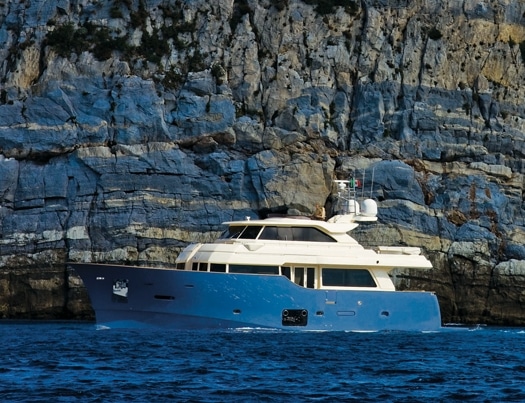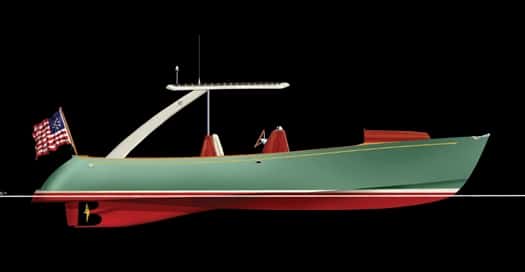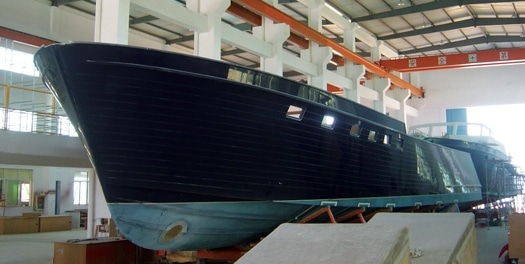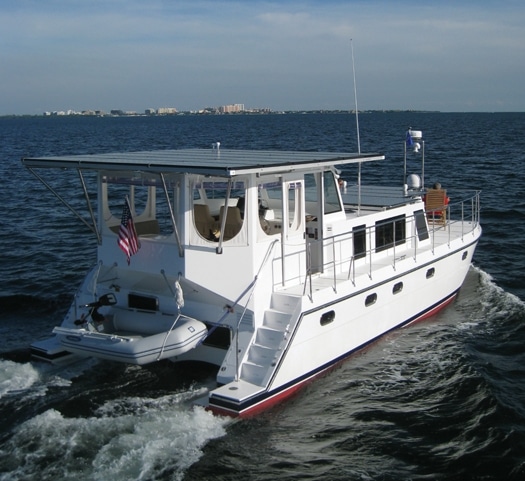
ytgjun09green525.jpg
Yacht technology is on the move, from super-efficient propulsion systems to squeakyclean electricity, from slippery sections that glide through the water to lightweight hulls built without a drop more resin than they need. Things are moving so quickly that a boat’s lines are now sometimes drawn with open spaces where the enginerooms, fuel tanks, even battery banks, will go. The philosophy seems to be: “leave those for as long as you can, and see what will be available to fill the space and the needs.”
The bottom line is that boats may begin to function differently than they ever have before. the evolution of yacht design is taking a sharp turn toward efficiency-of propulsion systems, of hulls moving through the water, of electrical appliances and lights on board-and what’s around the bend may affect how we use our boats and how they respond to the conditions we find at sea.
Silent Running
As with many developments and trends throughout yachting’s history, custom design adds a distinctive voice to the conversation. Some designers do their best work when presented with a very specific challenge.
So when a particular client approached Stephens Waring White Yacht Design (www.swwyachtdesign.com) in Brooklin, Maine, with a special challenge, yacht designer and partner Bob Stephens and his colleagues jumped at the chance.

| | |
“Their house is right on one of the most beautiful, unspoiled stretches of water I have ever seen. And they’ve been very accustomed to enjoying that water in various manual-powered craft: They have a peapod that they like to row and sea kayaks and also a nice daysailer. They were interested in expanding the range that they could cover with a boat, and so a powerboat made sense. So they were looking for a boat that would be low impact in the resources it would consume during its life and also low impact in the noise area. They’re very, very keen on reducing its noise footprint.”
The boat took on an interesting new dimension as the designers began to review possible engines and propulsion systems.
“We designed it based on a powerplant that was rumored to be coming out,” Stephens says. “And we now in fact have the powerplant in hand at [builders] French & Webb-so that’s good!” The propulsion system is a hybrid drive, a 110-horsepower Steyr diesel with a motor-generator bolted to its aft end that also works as the starter motor for the engine. To get the silent running the clients wanted, the boat will have a bank of batteries to store the power generated by running with the diesel.
“There’s been a lot of development in Lithium-ion batteries since we designed the boat, and it’s quite likely we will use them.” says Stephens. “But we haven’t been able to fully realize the advantage of those batteries because we designed the boat around the heavier lead-acid batteries.” Interestingly, the Lithium-ion batteries allow systems to access more of the power they hold, so the system can have smaller capacity than it would need with lead-acid, yet improved performance. Upfront costs for a Lithium-ion bank are considerably higher-roughly six times the expected cost of the lead-acid batteries-but they will be easier to use over the life of the boat and will end up costing about a quarter as much as the lead-acid batteries, which need regular replacement.
But hybrids and batteries are not revolutionizing travel on the water as some would say they are on the roadway. “It’s very difficult to make a tremendous impact as far as being green,” says Stephens. “The savings that hybrid cars realize, for example, aren’t really there in a boat because it just operates in a very different environment than a car. A car is constantly accelerating and decelerating. A boat is really a steady-state operation, so you can sort of predict your energy needs and they don’t change much-there’s no opportunity for regaining energy through regenerative braking or coasting down hills or anything like that. It just doesn’t happen. So as far as saving resources there are two ways that this boat does that and the first is the low-resistance hull which I think is a really important point.”
The slippery hull owes some of its attributes to successful designs from William Atkin from the 1920s and ’30s, right down to the small tunnel in the stern. “Even without the hybrid package, the boat would be a very efficient boat to operate with a small diesel,” says Stephens. “And it would be very easy on fuel and so would reduce impact on the environment that way. And it does have a limited number of solar panels on the canopy. In Maine in the summertime [the solar array] will offer enough power to recharge the boat from a fully discharged state-with batteries at 50-percent capacity-in about five days or so. So it’s not like the solar panels are going to keep the boat charged and you can run the boat without any diesel fuel. But they are there to help.” This is how design evolves. The technologies at hand-or those that will soon be at hand-are combined in such a way to optimize certain attributes, in this case, one client’s appreciation for the sound of water on a hull.
From the Ground Up
****David Marlow, chairman of Marlow Yachts (www.marlowyachts.com), has some definite ideas about what it means to be green. As with seemingly everything he does, his standards are quite high. And his green initiatives extend to-or more accurately, began with-the construction of his factory campus in Chi Hu, China, where his boats are built.
“Our policies have been, since the first shovel touched ground, to protect the environment by proactive movements to that end,” says Marlow. “Before we began construction at the oceanfront property we bought, we removed 24 inches of topsoil, so that we could then cover the entire premises with crushed granite and pea gravel to act as a filter for all water on site, from washwater to rainfall. The perimeter of the property is surrounded by a hand-cut granite wall, extending six feet below grade to provide an impermeable wall should the unthinkable ever happen-a chemical or oil spill on site.” The water reserved by this system is used to water vegetable gardens and fruit orchards that help to feed the 600-plus workers there. In addition, the company has begun a plantation to grow trees, including teak and mahogany, to mitigate its use of hardwoods in yacht production.

| | |
“Our yachts are a part and parcel of our environmental policies, with continuous research to lower resistance, [and] improve engineand-hull-combination efficiency while reducing our carbon footprint,” says Marlow. “In 2009, we introduced our solar-powered hardtop that produces enough free electricity each day to power 100 percent of the onboard appliances and entertainment systems, excepting air conditioning for any location south of Jacksonville, Florida.”
Marlow Yachts uses its proprietary Full Stack Infusion construction method, in which an entire hull is laminated in one shot with precisely measured modified epoxy resin. This process protects workers from exposure to dangerous chemical emissions from the process, while eliminating the waste created by multiple infusions and secondary laminating. According to Marlow, the construction results in less hull flex, which reduces the impact of forces that can cause delamination and makes the boats last longer-keeping the resources that went into them from ending up in a landfill, and preventing the owner from needing a replacement, at least until it’s time to upgrade.
“We treat [our workers] as the valuable assets they are, and do not allow them to expose themselves to danger in chemicals, unsafe practices, or defective tools and equipment,” Marlow explains. “They respond by building the highest-technology yachts on earth, equal in engineering, finish, and materials with the world’s finest.”
Marlow Yachts is also tweaking its designs to be more efficient. “On the hull design front, we have reduced the beam water line of all our yachts by approximately five percent, giving up approximately one half knot of top speed for a higher cruise speed and 10-percent reduction in fuel burn at cruise,” says Marlow. “This was also assisted by a slight change in prismatic coefficient to provide a more slippery section and overall view to passing water.”
And since that water passes the hull more easily, the yacht uses less fuel and gains more range, and the carbon footprint of all aboard continues to shrink.
Let It Shine
****”Once you go out on the DSe at six knots without any noise, you’ll understand what you’ve been missing, and what you’re missing is the noise,” says Reuben Trane, president of Island Pilot (www.islandpilot.com). “Noise is called noise pollution.” What Trane is talking about is what the sailors among us have known for a long time-the sound of the sea is part of the experience. And he gets that too, but he wants to have the amenities of a powerboat. That’s where his DSe hybrid, a catamaran cruiser with diesel and electric propulsion and a huge array of solar panels, comes into play.
“Now you have hybrid, the whole idea of this solar-powered boat is that you can get on the anchor and never run the diesel generator,” says Trane. “You’re living the pure life like a sailor, but you’re in the lap of luxury like the worst stinkpotter out there. You’ve got air conditioning, you’ve got color satellite TV, refrigeration, ice cubes, microwave. You’re living a very high quality of life, but without a generator banging away somewhere in the basement of the boat.” Trane combines the latest technologies into one vessel to dial up the efficiency and make things work on finite power resources. And he’s thought about where electricity, and the other resources that go into the boat come from.

| | |
“Sucking power off the grid: That’s not in and of itself a bad thing, unless that grid power is coming from a coal-fired plant someplace, or an oil-fired plant,” says Trane. “If it’s coming from an atomic plant, or if it’s coming from hydroelectric or a wind farm or a solar farm, that’s one thing, because they’re all renewables. But if it’s coming from coal or oil or natural gas, and you can’t control that when you plug in at the marina, you don’t know where the power is coming from. We’re going to replace all the rainforest woods in the boat with bamboo, which is essentially a weed. It’s all in greening of the product. As much as we can control on the product we will. Obviously if you put a flatscreen TV there’s going to be lead and stuff like that in there. Or the [navigational electronics]: You can’t control what goes in that. But we can choose the wood.”
Trane can’t just think about getting cool technology into his boats, he’s also got to look at the marketplace. “We’re not scientists, we’re in the boat business,” he says. “And we have to make a product that’s going to sell at the end of the day.” That said, Trane’s hybrid has taught him a thing or two about power management, and where those lessons can be applied.
“We’re looking at taking some of our power-management systems and backing them into our monohulls,” Trane says. “Where we would be able to put a little bit of solar up on the flybridge bimini. Imagine a nice 45-foot luxury yacht being able to sit on the hook amongst a bunch of sailboaters and not run a generator all night. But it takes a serious effort in energy management, which means a lot of very expensive batteries, with an expensive battery-management system with very high-tech, high-output inverters, and efficiency at the end of the appliances-the air conditioning, cooking, refrigeration. But if you do all that with a holistic approach, you can end up with a normal boat that can be green on the anchor.”
And as an ancient Asian proverb says, even the longest journey begins with a single step.









